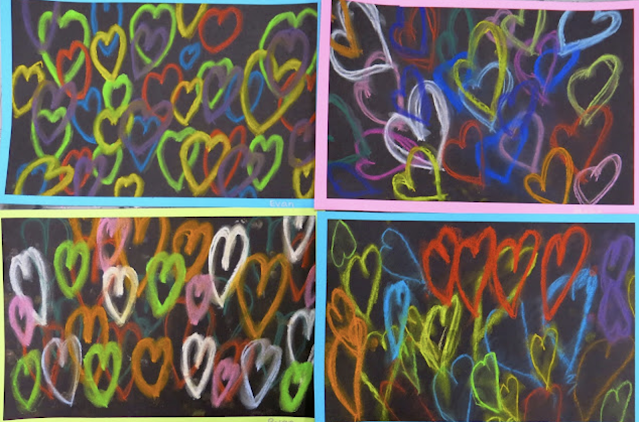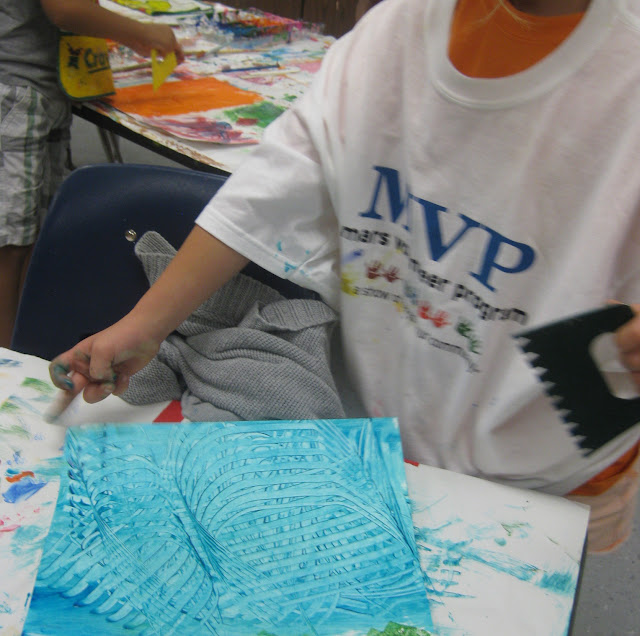Okay, listen, I get it. We're still in December and you may not want to be thinking about what's gonna go down in your art room next week (or this week? Do you return to school on Friday?). Regardless, I thought I'd help you out by offering some of my favorite EASY and engaging lessons that will allow you to ease your way back to the art room. Most of these lessons have a video so you can play that for your students while you grab your coffee and try to remember what day it is.
Now, if you want a demo on how to create the stamped heart background, be sure and check out the panda video (below) as I walk you through those initial steps.
Here's how you can draw a long with me to create this fox:
And here's how to create the background and draw that panda:
And last but not least!
For your older students, third on up, they may enjoy creating this 3-D heart!This one is super low-mess as all it requires are markers, water and a paintbrush (and an oil pastel once dry, but that's totally optional). I share the details in this blog post.
This project was done in just 30 minutes (the length of my art classes) and only uses chalk! I was also able to introduce my students to a contemporary artist for the process. Details here!
This is probably one of my all-time fave kid-approved lessons: this Chris Uphues-inspired heart art!
If you need a line review lesson, you might want to try these Romero Britto-inspired hearts on for size!
And if you are looking for a lesson that packs a powerful contemporary artist punch, then THIS lesson with an introduction to four artists who use hearts in their art is the one for you! I did this on a half day with fourth graders and they knocked it out in one class period!
Of course, since we are going to be talking about hearts, now is also a great time to either introduce or review SHAPES! Don't forget...Alfred can help you with that!

Read more »
Let's start here! This lesson is ALWAYS a hit and, believe it or not, I do it with kindergarten. HOWEVER...when I return to school after a long break, the last thing I wanna do is prep like mad for 5 different grade levels. It stresses me out and, because our students our little mirrors who reflect us, it stresses the kids out. SO! I often do this lesson with EVERYBODY, kindergarten through 4th. Does it make for a lotta messy paint trays, paintbrush washing and overflowing drying racks? YES. But does it also make for a gorgeous display of hearts created by the whole school that is ready to be hung BEFORE Valentine's Day (always the goal, right?!). Yes! So, let's go. Full lesson here.
This is a fun one and totally addictive so...beware!
If you want to start with a little less mess, then just bust out the black, red and white oil pastels and get the kids drawing! They adore drawing cute stuff and these little Valentines critters are perfect for that. I created a video for each. You can check out the blog post with all the info here. We also did a stamped background that is totally optional. Here's the video for the bunny:Now, if you want a demo on how to create the stamped heart background, be sure and check out the panda video (below) as I walk you through those initial steps.
Here's how you can draw a long with me to create this fox:
And here's how to create the background and draw that panda:
And last but not least!
Let's draw this cute Valentine's Pup!
For your older students, third on up, they may enjoy creating this 3-D heart!
This project was done in just 30 minutes (the length of my art classes) and only uses chalk! I was also able to introduce my students to a contemporary artist for the process. Details here!
Of course, you should definitely share my book Larry the Line which also has two printable pages of line-inspiration in the back!
And if you are looking for a lesson that packs a powerful contemporary artist punch, then THIS lesson with an introduction to four artists who use hearts in their art is the one for you! I did this on a half day with fourth graders and they knocked it out in one class period!
Of course, since we are going to be talking about hearts, now is also a great time to either introduce or review SHAPES! Don't forget...Alfred can help you with that!
Remember: take it easy as you ease on in to this new year! Have fun!


















































































